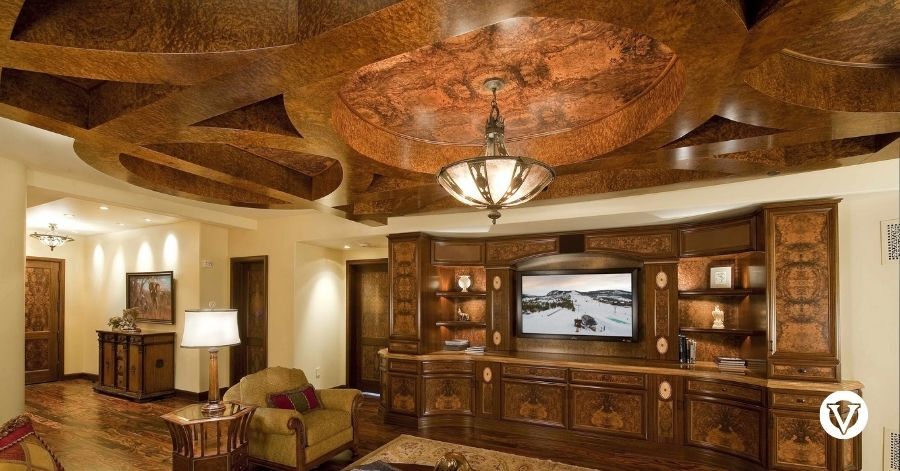Wood veneer and laminate are the two most popular material choices for finishing cabinets, furniture, and millwork in architectural projects, but they offer vastly different characteristics regarding material, appearance, durability, and cost. Choosing between them often comes down to balancing budget with the desired aesthetic and expected wear-and-tear.
This comprehensive guide breaks down the pros and cons of each material to help you make the best specification decision for your project.
1. Architectural Wood Veneer
Wood veneer consists of thin slices of real wood (typically 0.5mm to 1.5mm thick) that are expertly bonded to a core material, such as plywood or MDF (Medium-Density Fiberboard). Veneer delivers the genuine, natural beauty of solid wood at a fraction of the cost.

Veneer Pros: The Natural Choice
|
Feature |
Description |
|---|---|
|
Authentic Appearance |
Since it is made from 100% real wood, veneer provides a rich, authentic wood grain, texture, and warmth that cannot be truly replicated by synthetic materials. It is the premier choice for high-end furniture and luxury finishes. |
|
Unique Patterns |
Every piece of wood veneer is unique. Natural variations in grain, color, and figure (like flexible sheet veneer or figured woods) add character and depth to the final product. |
|
Can Be Refinished |
Veneers can be lightly sanded and refinished to repair minor scratches or update the color, extending the lifespan of the piece. |
|
Environmentally Friendly |
Veneer is a sustainable solution, as it uses significantly less precious wood than solid wood construction, maximizing the yield of rare species. |
|
Seamless Large Panels |
Veneer sheets and veneer panels can be meticulously matched (sequence-matched or book-matched) to create flawless, continuous grain patterns across vast areas, a critical feature for architectural wall panels. |
Veneer Cons: Handling and Maintenance
|
Feature |
Description |
|---|---|
|
Susceptible to Damage |
Wood veneer is more prone to deep scratches, dents, and surface water damage than laminate. Prolonged exposure to moisture can cause warping or peeling if the edges are not sealed properly. |
|
Limited Refinishing |
Due to the thinness of the wood layer, veneer can only be sanded and refinished a limited number of times before the core material is exposed. |
|
Higher Cost |
While less expensive than solid wood, high-quality wood veneer sheets are typically more expensive than synthetic laminate products. |
|
Sensitive to UV |
Prolonged exposure to direct sunlight can cause natural fading or color changes (patina) over time. |
2. High-Pressure Laminate (HPL)
Laminate is a synthetic material created by fusing layers of paper or fabric with thermosetting resins under high heat and pressure, which is then bonded to a substrate like MDF or particleboard. It is engineered for durability and is designed to mimic the appearance of wood, stone, or other materials.
Laminate Pros: Durability and Budget
|
Feature |
Description |
|---|---|
|
Exceptional Durability |
Laminate is highly resistant to impact, scratches, abrasion, heat, and moisture, making it an excellent choice for high-traffic areas like commercial kitchens, school furniture, and laboratory settings. |
|
Low Maintenance |
It is extremely easy to clean and maintain, requiring only basic wiping with mild soap and water. |
|
Ideal for Painting (BFV Exclusive) |
Our specialized paintable laminate (available in two thicknesses) offers a superb, seamless, non-grain surface, eliminating the need to paint over grainy Birch or Maple veneer. The patent-pending BFV backer is perfect for nearly any gluing application, and the laminate can be easily cut with a knife due to its flexibility. |
|
Cost-Effective |
Laminate is significantly more affordable than wood veneer, making it the preferred solution for budget-conscious or large-scale projects. |
|
Variety of Designs |
Laminate is available in thousands of colors, patterns, and textures, including faux wood looks and hyper-realistic stone finishes. |
Laminate Cons: Appearance and Repair
|
Feature |
Description |
|---|---|
|
Artificial Appearance |
Despite advances in technology, laminate surfaces often lack the natural depth, warmth, and uniqueness of real wood grain, especially upon close inspection. |
|
Cannot Be Refinished |
Once the top layer of laminate is scratched or damaged, it cannot be sanded or repaired. Any significant damage usually requires complete panel replacement. |
|
Visible Edges and Seams |
Laminate often requires matching edge banding, and seams between sheets can be visible in certain applications, which can detract from the aesthetic continuity. |
|
Environmental Impact |
As a synthetic product, laminate can have a larger environmental footprint than natural, sustainably sourced wood veneer. |
Comparison Summary: Wood Veneer vs. Laminate
|
Feature |
Wood Veneer (The Real Wood Finish) |
Laminate (The Durable Synthetic) |
|---|---|---|
|
Material |
Real wood slice, bonded to a core. |
Layers of resin-infused paper, bonded to a core. |
|
Aesthetic |
Natural, unique grain; high-end look. |
Mimics wood/stone; uniform appearance. |
|
Durability |
Prone to scratches/moisture; needs topcoat protection. |
Highly resistant to impact, heat, and moisture. |
|
Refinishing |
Can be lightly sanded and refinished. |
Cannot be refinished; must be replaced if damaged. |
|
Cost |
Mid to high-range (more expensive than laminate). |
Low-range (most cost-effective option). |
|
Best Uses |
High-end furniture, custom cabinets, executive offices, architectural wall panels. |
Kitchens and bathrooms, high-traffic retail, budget projects, and school or office furniture. |


